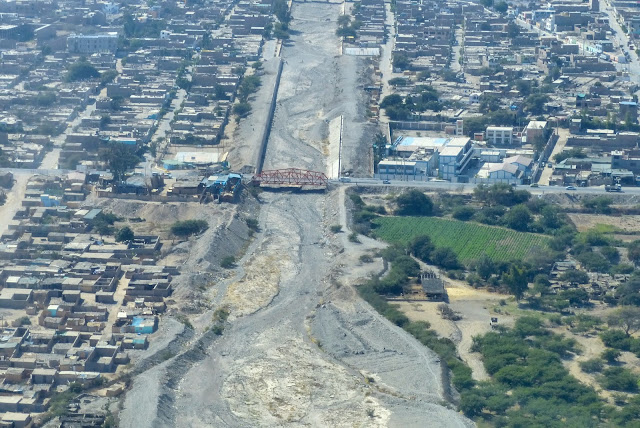The
Nazca lines are lines of 10 to 15 cm deep in the Atacama dessert on the Nazca plateau In Peru. The surface of this desert is covered with red rocks (Pampa Colorada). There is no wind and no rain.

Looking from the Maria Reiche tower, the dessert is completely flat. On the other side of the road (the parking place - note the chemical toilet) you see the mountains.
To construct the lines the Nazca people removed the red stones to make the underlying bright lime visible. This was around 400 to 650 AD.
The lines in the desert of Nazca are best seen from the air. You're supposed to see something from the
Maria Reiche tower (I didn't climb the tower) and from a mountain ridge, but the best view is from a plane. We flew in a small 5 passenger Cessna. Seats are distributed by weight. So in the airport we went on the scales with all the gear we wanted to take with us on the plane. I was seated in the back (rather low) but with a view on both sides....
In the airport there is a schematic map of the lines and figures that you get to see when flying over the desert.

This is an aerial view of the Maria Reiche tower. The little dots on the left of the road are chemical toilets and probably a car on the parking place. When you look good you can see lines and nearer to the tower to the right a figure with two large hands and a tree. In the left corner you some damage done by cars. The road was build before they new of the existence of the lines.

What are these lines for? There seems to be no certain answer. Possibilities enough. An Observatory to determine the time of solstice combined with religious functions. Is there a relation to the water management? The water that comes from the Andes flows underground to the Pacific Ocean ( in the next blog more about drought and water). Agriculture and fertility were the main topic of religion.
And there was
Von Däniken with the theory of landing strips for astronauts from other planets. There is a figure called "the astronaut".
It was the first figure I saw. I missed the whale, but took a picture....
And here it is! We new they were hard to see and it was upside down. How could they see them standing just on a hill?
Here we see The Condor. And beautiful lines. No wonder people are so curious about their meaning / purpose.
A bit further on.... Two Frigate birds. One in the middle and one with the half circle (not so clear).
On this promontory something that looks very much like a landing strip... with a Hummingbird.
Then there is a Parrot ...
... and a Spider ....
The Spider is also surrounded by fantastic lines.
Flying back we see more of the landscape. Dry, but with traces of rivers. Nothing seems to change in this landscape (as long as people don't interfere).
Ah.. yes, the river..... Not a drop of water.
Almost back.....









































